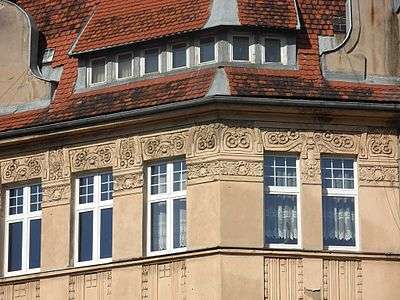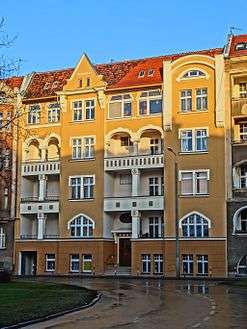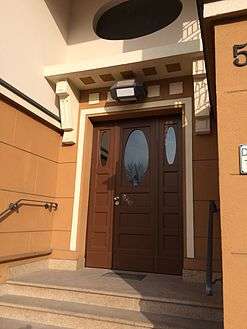Adam Mickiewicz Alley
| Bydgoszcz | |
|---|---|
| <span class="nickname" ">Polish: Aleja Adama Mickiewicza w Bydgoszczy | |
 View of the street | |
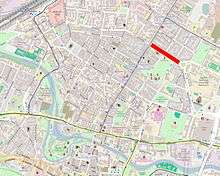 Location of Adam Mickiewicz Alley | |
| Part of | Bydgoszcz Old town district |
| Namesake | Adam Mickiewicz |
| Owner | City of Bydgoszcz |
| Length | 400 m (1,300 ft) |
| Location | Bydgoszcz |
| Wikimedia Commons has media related to Mickiewicza Street in Bydgoszcz. |
| Wikimedia Commons has media related to Józef Weyssenhoff Square. |
| Wikimedia Commons has media related to Jan Kochanowski Park. |
Adam Mickiewicz Alley is one of the main streets of downtown district in Bydgoszcz.
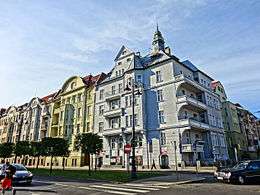
Location
The street links Gdańska Street to Józef Weyssenhoff Square. Its northern frontage is a set of tenements and villas built in the first decade of the 20th century. On the southern side are located the Polish Theatre and Jan Kochanowski Park.
Naming
Adam Mickiewicz Alley
- 1906-1920, Bülowstraße, after Bernhard von Bülow;
- 1920-1939, Aleje Adama Mickiewicza after Adam Mickiewicz;
- 1939-1945, Felix-Dahn-Straße, after Felix Dahn;
- Since 1945, Aleje Adama Mickiewicza
Józef Weyssenhoff Square
- 1906-1920, Bülowplatz, after Bernhard von Bülow;
- 1920-1933, Plac Zacisze ("Tranquility Square")
- 1933-1939, Plac Józefa Weyssenhoffa, after Józef Weyssenhoff, polish writer and literary critic, who lived at N°1 from 1924 to 1928;[1]
- 1939-1945, Johann Fichte Platz, after Johann Gottlieb Fichte;
- Since 1945, Plac Józefa Weyssenhoffa.
History
Adam Mickiewicz Alley
Adam Mickiewicz Alley has been laid out in 1903, in the conditions of an urban development of the eastern area of Gdańska Street called "Hempelscher Felde":[2] this plot was bought in the 1890s by the municipality to develop its urban plans based on a garden city concept developped by Hermann Stübben.[3]
The highlight of the whole project was the Bülow street, then one of the most beautiful and widest thoroughfare of the city. It comprised a dual carriageway starting from Dantziger strasse, running eastward. The perspective was particularly taken care of, emphasized by a row of trees, with stretched garlands of vines.[4] At the same time, the Ossolińscy street, continuation of the axis from Weyssenhoff square, was defined in its main features.
The northern frontage of Adam Mickiewicz Alley has been conceived from 1903 to 1907 as an homogeneous complex of Berlin Art Nouveau tenements, similar to what has been erected at the same time in Dworcowa Street (N°45, 47, 49). In 1910, an addition to the frontage, consisting of villas and houses has been erected. The perspective of the street to the east has been closed by the building of the Institute of Agriculture (Ger. Kaiser-Wilhelm-Institut für Landwirtschaft), then the first high school scientific department in Bromberg.[2]
In 1949, the Polish Theatre has been completed, standing at the intersection with 20 January 1920 Street. In 1960, the Archer Statue has been moved from Theatre square to Jan Kochanowski Park. Most of the facade decorations and reliefs have been deteriorated by lack of treatment during the post-war years.[5]
The street has undergone a gradual revitalization after 1990. Between 2002 and 2009, all street facades have been was renovated, and, when possible, restored with their original decorations.
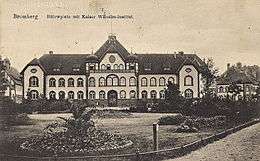
Józef Weyssenhoff Square
The square was founded in 1903 in the same conditions as Adam Mickiewicz Alley. It is a triangular square from which radiate:[6]
- Adam Mickiewicz Alley in a north-westerwards,
- Ossolińscy street (Ger. Hohenzzolernstrasse) to the south-east.
In the middle was planted flowerbeds, shrubs and trees. In 1926, coniferous and deciduous trees were put.[7] Between 1905 an 1911, a frontage of five-story apartment buildings have been built, following Art Nouveau and Historicism styles.
Jan Kochanowski Park
This green estate runs on the southern side of Adam Mickiewicz Alley, between January 20, 1920 street on the west and Ignac Paderewski street on the east, extending to the south till the Pomeranian Philharmonic.
History
Jan Kochanowski Park has been designed by Konrad Neumann, director of Bromberg's city gardens in 1901, its original size was 2.8 hectares. Works have been carried out from 1903 to 1911, in concordance with the urban development of this area at the time.[7] It was realized as an English garden with approximately 80 species of trees and shrubs.
On July 31, 1927, has been held in the park the unveiling ceremony of the monument to Henryk Sienkiewicz, the first in Poland.[7] In 1938, a park record listed 84 species of trees and shrubs.[7] Main highlights were Scots Elms and poplars 25 meters tall, English oaks with stem circumference of 300 to 480 cm and large silver maples and Hornbeams.[7]
After destructions of World War II, a part of the park has been replanted. In 1952, during the construction of public toilets, 4 oaks with trunk circumference of 400 cm have been cut down.[7] In 1958, the park area has been reduced to the south to allow the construction of Pomeranian Philharmonic building. In 1960, in the northern part of the park has been placed "The Archer", an iconical statue of the city, till then on Theatre square.
Mid-August 2015, a complete restoration of the park, designed to highlight its historical character and relationship with the "Music District" has ended.[8][9] New species have planted, such as hornbeams, birches, Douglas fir, varieties of Berberis, sea buckthorns, or lilacs. Part of this thorough renovation project was also the building of a new fountain of "Son et lumière" before the Pomeranian Philharmonic building, unveiled on May 23, 2014.[10] The park Kochanowski and the surroundings of the Pomeranian Philharmonic building comprise 21 tree specimens listed as Polish monuments of nature.
Naming
Since its inception, the park bore the following names:[11]
- From 1910 to 1920, Bismarck Garten;
- From 1920 to 1939, Jan Kochanowski Square;
- From 1939 to 1945, Bismarck Garten;
- Since 1945, Jan Kochanowski Park.
Monuments
Jan Kochanowski Park of is characterised by a large number of monuments. The first one has been unveiled in 1927: first monument in Poland to Henryk Sienkiewicz, realized Konstanty Laszczka,[12] in front of thousands people, hundreds of officials and Polish president Ignacy Mościcki. This very monument has been destroyed by Nazis in September 1939. Since 1960, the park boasts the most valuable public sculpture in Bydgoszcz, the "Archer" by Ferdinand Lepcke, considered a symbol of the city. In addition, due to the proximity of the Pomeranian Philharmonic and the Bydgoszcz Academy of Music, the park has been a show case for an outside collection of sculptures of eminent composers and virtuosos of classical music.
In 2015, the following monuments were present in the park:[13]
- Sculpture "The Archer"by Ferdinand Lepcke (1910), originally placed at Theatre square;
- Henryk Sienkiewicz monument by Stanislaw Horno-Poplawski (1969), which replaced the first one unveiled in 1927;
- Statue of martyrdom in honor of the 50 high school students who were murdered on September 5th, 1939, by Joseph Makowski;
- Gallery of composers and virtuosos - 15 monuments of prominent Polish and foreign composers and virtuosos of classical music;
- Memorial to Andrew Szwalbe, by Michał Kubiak, (2007).
-
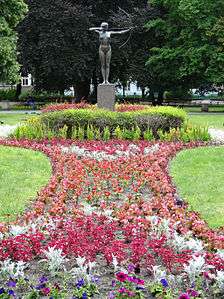
"The Archer" by Ferdinand Lepcke, author also of the Deluge Fountain
-
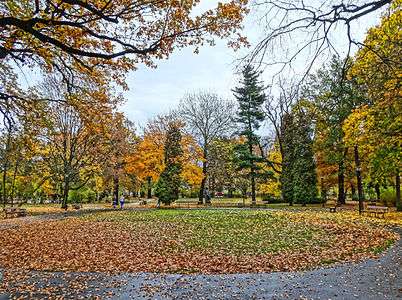
"The Archer" with the Polski theatre in the background
-

Monument to Henryk Sienkiewicz
-

"The Archer" by night

Architecture
Frontages of Mickiewicz alley (N°1 to 9) and Józef Weyssenhoff Square compose a complex of townhouses inscribed in the German variant of Art Nouveau architecture (Ger. "Jugendstil"). Predominant forms evoke quietness, through varied bay windows, divided balconies and loggias integrating wavy lines, wavy gables, vaulted windows and portals. Decoration combines organic themes with geometric forms, like rectangular and square shapes, grouped in series and friezes. The ensemble reminds also Baroque style at by applying domes avant-corps and towers topped with peaks.[14]
The architects who designed those buildings were all inspired by Berlin architecture, "en vogue" at the time:[15]
- Rudolf Kern who built also tenements in Gdańska Street at N°5, N°67, N°66-38, N°71;
- Erich Lindenburger who constructed also in Dworcowa Street (N°41,43,45,47);
- Paul Böhm who realized houses on August Cieszkowski Street in Bydgoszcz at N°1 and 3;
- Otto Rosenthal;[16]
- Józef Święcicki, known for its dozens of realization in Gdańska Street.
For almost the entire post-war period, tenements have been property of the state. In 1990, the city of Bydgoszcz owned them back, but at the time, they were falling into disrepair as a result of underinvestment, lack of maintenance and general neglect of Art Nouveau monuments. Buildings have been restored after 2002.

Main places and buildings
Rudolf Kern Building, at N°1, corner with Gdańska Street
Registered on Kuyavian-Pomeranian Voivodeship heritage list, N°601377-Reg.A/1086, 20 November 1995[17]
1903-1904, by Rudolf Kern[18]
The tenement has been designed by the architect Rudolf Kern, a student of Józef Święcicki, for his own use, private and business: he has lived there until 1922.
-
View from Mickiewicz Alley
-
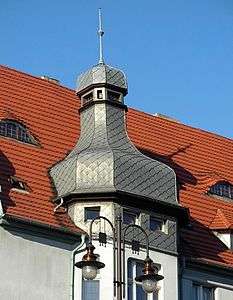
Detail of the peak
-
The ornamented gate
Polish Theatre in Bydgoszcz
N°2
1948-1949, by Alfons Licznerski
Polish Theatre "Hieronim Konieczka" in Bydgoszcz is the largest and best known theatre of the city. It is set at N°2. Current director is Paweł Wodziński.
-
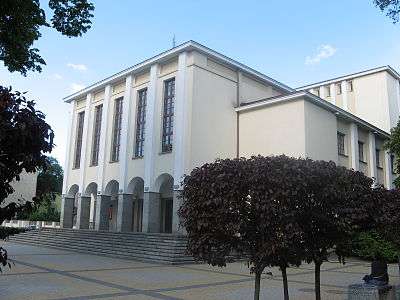
View from Mickiewicz Alley
-

Main entry
-

View from Jan Kochanowski Park
Tenement at N°3
1904-1905,[18] by Erich Lindenburger
Characteristic features are the ornate portal and decorative gable; the façade has pilaster strips which accentuates vertical divisions. Bay windows are divided with loggias. This building is the seat of the Honorary consulate of Czech Republic.
-

View of the frontage from Mickiewicz Alley
-
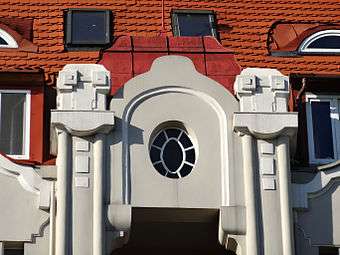
Detail of the tinned roofed bay window
-
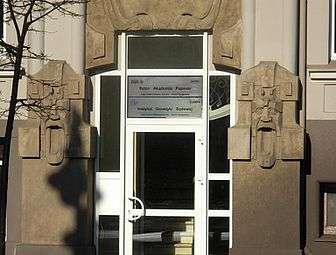
Grandiose front gate
-
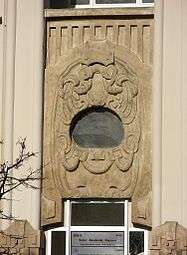
Front gate top
House at N°4, corner with Paderewski street
1906-1908[18]
Corner house displays with highly decorated balconies and bay windows. Roof possesses eyelid dormers.
-

View of the frontage from Mickiewicz Alley
-
Detail of portal and loggia
-
Detail of the gable with eyelid dormer
House at N°5,registered on Kuyavian-Pomeranian Voivodeship heritage list, N°601378, Reg.A/1081, 21 December 1994[17]
1906,[18] Rudolf Kern
Less adorned than its neighbours, this building displays anyhow the same Art Nouveau grandeur, with loggias and bay windows, as well as a curved top frontage and dormers on the gable.
-
View of the frontage from Mickiewicz Alley
-
The house and its flanking neighbours
House at N°7,registered on Kuyavian-Pomeranian Voivodeship heritage list, N°601379, Reg.A/1082, 10 January 1995[17]
1904-1905,[18] Rudolf Kern
N°7 looks like a mirrored shape of N°5, underlying the seal of the same Art Nouveau architect. Frontage adornament is much richer, with loggias, balconies and bay windows topped by helmet-style roof.
-
View of the frontage from Mickiewicz Alley
-
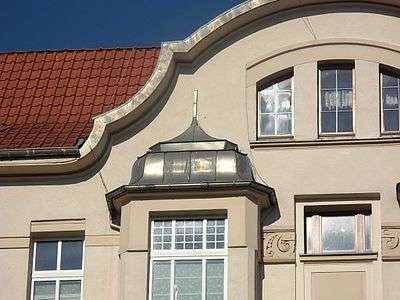
Detail of the roof
-
Gate at N°7
House at N°9, registered on Kuyavian-Pomeranian Voivodeship heritage list, N°601380, Reg.A/855, 28 August 1985.[17]
1905-1906,[18] by Rudolf Kern
The house was built by Bydgoszcz architect Rudolf Kern so as to establish the first private music school in the city, the Conservatoire of Bydgoszcz (German: Bromberger Konservatorium der Musik).[16] The school was founded in 1904 on the initiative of Arnold Schattschneider and was originally located at Gdańska Street 24, (German: Dantzigerstrasse 158).[19] The space in the building was soon too scarce, and decision was made to build a new edifice at Adam Mickiewicz Alley, using the opportunity of the urban development of the "Hempelscher Feldethe" area. Construction lasted from December 1905 to October 1906 when an opening concert took place for the opening of the new school premises.[16]
The building displays Art Nouveau style, using rich decorative forms. The facade is balanced with vertical and horizontal lines as well as balconies having each their own designed railing. The main entrance had two doors: one leading to the staircase to the conservatoroire, the other going to private spaces for the landlord and the school headmaster.[16] Inside, the school housed classrooms, instruments, an extensive library and a concert hall with Neo-Baroque features.[16] In the concert hall was organized symphonic concerts, chamber music events, concerts of students and monthly subscription concerts. In smaller venues were classes for piano, violin, cello and choral singing. Teachers of the conservatoire came from Vienna, Dresden, Regensburg, Prague, Rome, Moscow and Warsaw, classes comprised Germans and Poles.[16] Wilhelm von Winterfeld, second director since 1914, had the school moved in the early 1930s to larger premises at Gdańska Street, 54[20] (from where it moved again to Gdańska Street 71 in 1939). The interiors of the building in Adam Mickiewicz Alley have been entirely rebuilt to turn classrooms and auditorium into flats.[2] In 2002-2004 a major renovation of the facade has been carried out, giving back to the frontage its original design that had been lost since the postwar period.[2]
-
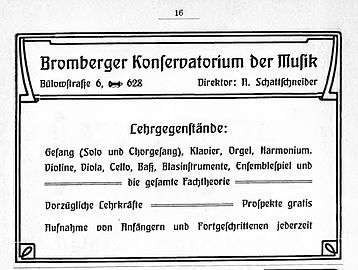
Advert. for Bydgoszcz Music Conservatoire ca 1906
-

View ca 1915, as "Bromberger Konservatorium"
-

Frontage view from the street
-
Art Nouveau ornamentation above the portal
-
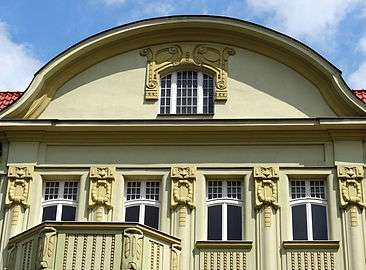
Stucco decor of the top level
-
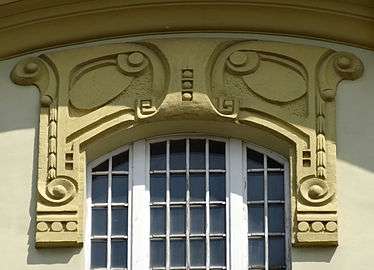
Window's adornment

Corner house with January 20, 1920 street,registered on Kuyavian-Pomeranian Voivodeship heritage list, N°601456, Reg.A/1080/1-2, 20th Dec. 1994[17]
1905-1906[18]
This corner house is characterised by its towering peak topped with a tin roof.
-

View ca 1914
-

General view of both frontages
-
Facade on Mickiewicz Alley
-
Facade on January 20, 1920 street
Corner house with January 20, 1920 street
1903[18]
This corner house displays also a nicely adorend portal.
-

General view of both frontages
-

Detailed view of facade decoration
-
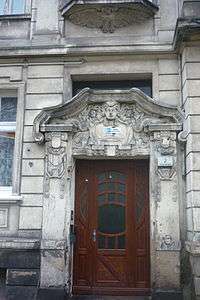
Detail of the gate ornamentation
Villa at N°11
1903-1904[18]
One of the few villas built during the initial development of the street.
-

General view of the villa
-
Detail of a facade window
Villas at N°13/15,registered on Kuyavian-Pomeranian Voivodeship heritage list, N°6601381, Reg. A/1067, 18 May 1994[17]
1903-1904[18]
One of the few villas built during the initial development of the street.
-

Villa at N°15 in 1912
-

General view of villas
-
Facade of Villa at N°15
-
Detail of the gate of villa at N°15
Villa Józef Święcicki at N°17
1906[18]
German Historicism
This villa was one of the buildings Bydgoszcz's architect Józef Święcicki realized for himself (see also Józef Święcicki tenement in Bydgoszcz).
-
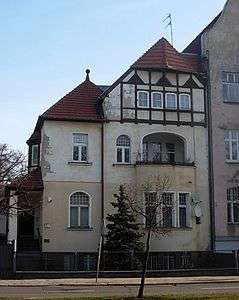
General view of the villa
-
Detail of the gate of Villa Józef Święcicki

Corner house with Paderewski street N°1
1905-1908[18]
This corner house displays typical tin roof above each of its bay windows.
-

General view of both frontages
Corner house with Paderewski street N°10
1905-1907[18]
This corner house starts the series of frontages characteristic of Józef Weyssenhoff Square.
-

General view of both frontages
Tenement at Józef Weyssenhoff Square N°1
1905-1906, by Rudolf Kern
This is the house Józef Weyssenhoff lived in from 1924 to 1928; a plaque has been placed on the facade in memoriam. Both facades display bay windows with loggias or balconies. A richly decorated frieze run at the bottom of the gable boasting dormers.
-

General view of frontages
-

Detail of portal decoration
-
Plaque on memoriam of J. Weyssenhoff
Tenement at Józef Weyssenhoff Square N°3
1905-190, by Erich Lindenburger
-
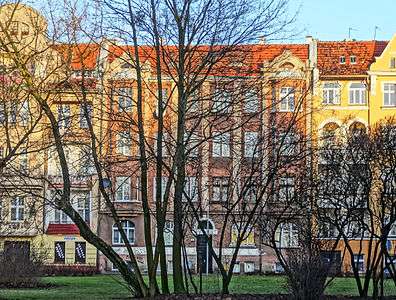
General view from the Square
-

Main elevation
Tenement at Józef Weyssenhoff Square N°5, registered on Kuyavian-Pomeranian Voivodeship heritage list, N°743201, Reg.A/1573, 29th Oct.[17]
1908-1909, by Paul Böhm
The facade display 3 levels of balconies. The building has been recently refurbished.
Tenement at Józef Weyssenhoff Square N°7
1909-1910
The facade is characterised by a balanced, even symmetry around the large arcade runnig above the entry gate. This round motif is recurrent through the whole frontage, from the ground level arcades up to the curved pediment.
-
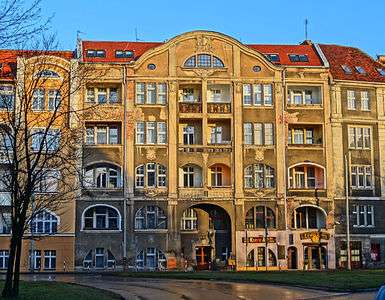
General view
-

Detail of the curved pediment
-
Main gate portal
-
Adornement of the portal
Tenement at Józef Weyssenhoff Square N°9,registered on Kuyavian-Pomeranian Voivodeship heritage list, N°725836, Reg.A/1522, 20 March 2009.[17]
1910-1911, by Georg Baesler
-
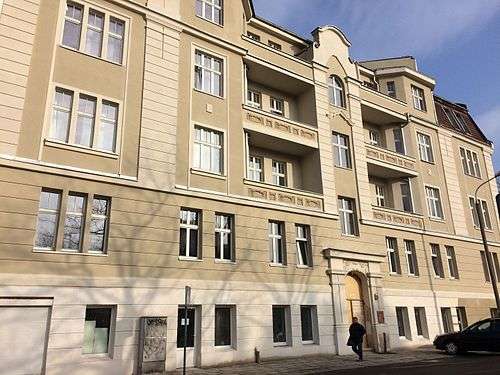
General view 2016
-
Detail of the entry gate
-

Motifs details
Building of the Institute of Agriculture,registered on Kuyavian-Pomeranian Voivodeship heritage list, N°601254, Reg. A/676/1-8, 20 May 1992.[17]
Józef Weyssenhoff Square N°11
1903-1906, by Delius
The architectural ensemble of the Institutes of Agriculture in Bydgoszcz occupies an area of 7.5 hectares, between Joseph Weyssenhoff Square, Ossolińscy Alley, Wielkopolski insurgents avenue and Karol Szymanowski street. The western area is laid out with buildings, the eastern one is a 5 ha zone of field vegetation, with livestock, greenhouses and a barn.[21]
In October 1902, the Prussian government took the decision to create in Bydgoszcz research institutes for agriculture (Ger. "Landwirtschaftliche Versuchs und Forschunganstallten"). Preliminary blueprints were performed in 1903 by construction engineer Delius. Construction works began in April 1903, and official opening of the Institute took place on June 11, 1906. Its name was changed in September 1906 to Kaiser Wilhelm's Institut für Landwirtschaft zu Bromberg, it kept it till the end of World War I.[21] Under the terms of references, the institute had received research, experimental, scientific and advisory tasks. To carry out them, the organizational structure of the institute was made up of four divisions:[22]
- Agricultural chemistry, Bacteriology and breeding seeds
- Drainage
- Plant pathology
- Veterinary medicine
In 1912, the institute created an experimental farm in Mochle near Bydgoszcz, where extensive research on nutrition and development of plants and animals in natural conditions were conducted,[22] and another one in Pęchowo.[22] The institution conducted also very active public lectures about all training fields, from botany and agricultural bacteriology to agrochemicals and plants or animals diseases. Unfortunately, various internal and external conflicts forced the school to move to Cieszyn in September 1922/1923.[23] During German occupation, the organisation conducted further research, although suffering significant losses. In autumn 1939, director Dr. Vladimir Kulmatycki,[21] together with many scientists, technicians and administrative personnel were killed in mass executions.[24] After World War II, the institute became a branch of the National Institute of Scientific Agriculture based in Puławy. In the 1980s, new buildings were erected on Wielkopolski Insurgents Avenue, where were gradually transferred the existing scientific institutions. The 60 000 volumes of the 1906-established Agricultural Library have been equally distributed in 2004 between the Central Agriculture Library in Warsaw and the library of the University of Casimir the Great in Bydgoszcz (UKW). In 2010, the following buildings of the institute were handed over to UKW:
- The main building at Weyssenhoff Square 11, to the Faculty of Mathematics, Physics and Technology;
- Building at Ossolińscy Avenue 12, to the Faculty of Natural Sciences;
- Buildingat Wielkopolski Insurgents Avenue 2, to the Faculty of Pedagogy and Psychology.
All the buildings of Bydgoszcz Agricultural Institutes have been erected with reference to the Prussian architectural national style, such is also the High Seminary of Bydgoszcz in Grodzka street. The predominant architecture style is eclecticism, with Historicism and Secession influences.[25] Due to the clay soil, buildings foundation had to be reinforced with concrete rails. Roofs are covered with Monk and Nun tiles with spires made from sheets of zinc or copper.[21] Building at Joseph Weyssenhoff Square N°11 is the largest one of the ensemble: it housed originally Institutes of Plant Pathology and Drainage, plus administrative offices. The edifice displays separated avant-corps (one on each side, one in the middle of the facade), roofs are steep ones, some are metal covered. A small panoramic terrace was installed at the top of the highest roof. The middle avant-corps on the front façade still exhibits an oak door with oval shaped transom light made of cristal panes. On the Transom (architectural), a Neo-Baroque cartouche with the symbols of agriculture (a beehive, a shovel, a hoe and a plow) is visible, including cornucopias overflowing with fruits.[21]
The basement housed a boiler room, warehouses for glasses and chemicals, coal storage and services apartment. On the ground floor was the central hall with stairs, the office director, an administration room and library, laboratories, zoological, chemical and botanical experimentation rooms. On this floor were also lecture halls (126 and 188 seats) and a large amphitheater (190 seats), equipped with table experimental and overhead projector. On the first floor were another conference room, a reference library, a drawing room and a weather station. The attic sheltered a photographic studio with darkroom and two apartments for assistants. The main hall and corridors were adorned with cross vaults. Inside, one can still see the preserved forged railing of the staircase decorated with stylized acanthus leaves, multicolored terrazzo on the floors and a wooden coffer ceiling in the hall.[21]
-

Institutes of Agriculture ca 1908
-
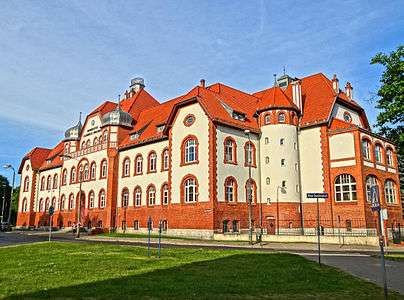
General view from Plac J. Weyssenhoff
-
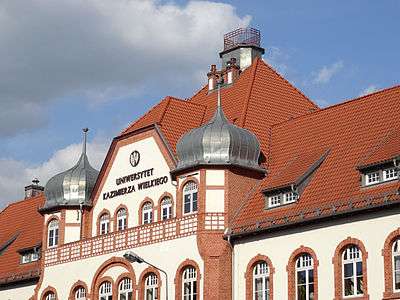
Main avant-corps with tin roof, the observatory on top
-
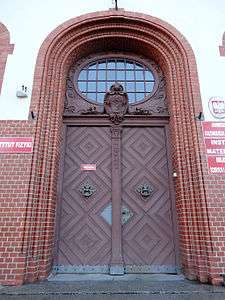
Main gate
-

Transom light and its decorated cartouche
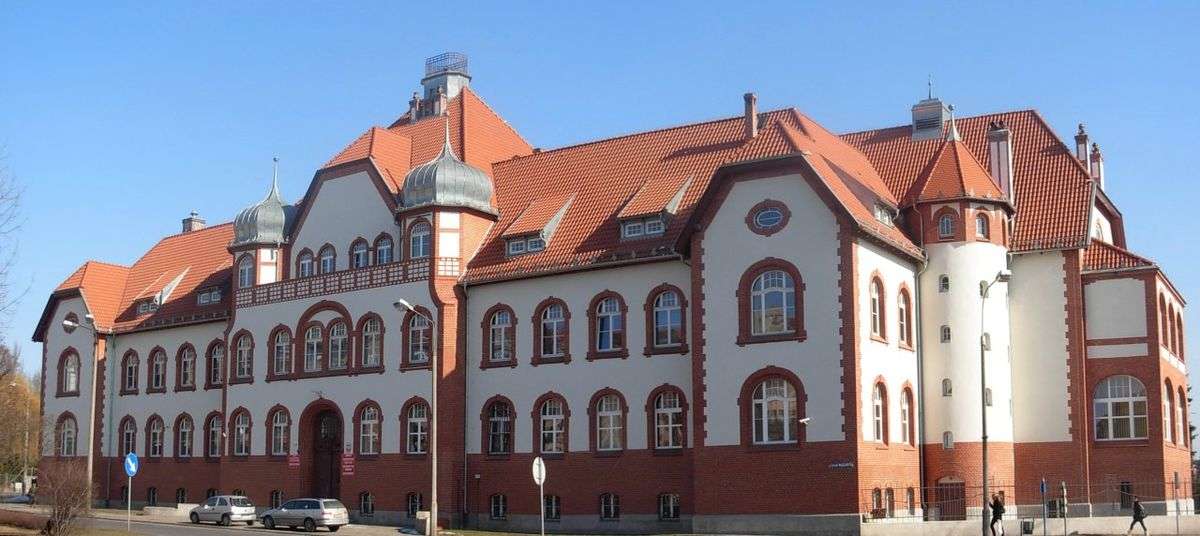
See also
- Polish Theatre in Bydgoszcz
- Pomeranian Philharmonic
- Gdańska Street, Bydgoszcz
- Ossoliński Alley in Bydgoszcz
Bibliography
- (Polish) Majchrzak Agnieszka: Bydgoskie Konserwatorium Muzyczne. [w.] Materiały do dziejów kultury i sztuki Bydgoszczy i regionu. Zeszyt 1. Pracownia Dokumentacji i Popularyzacji Zabytków Wojewódzkiego Ośrodka Kultury w Bydgoszczy. Bydgoszcz 1996
- (Polish) Bręczewska-Kulesza, Daria: Przegląd stylów występujących w bydgoskiej architekturze drugiej połowy XIX i początku XX stulecia
- (Polish) Bręczewska-Kulesza Daria, Derkowska-Kostkowska Bogna, Wysocka A., [i inni]: Ulica Gdańska. Przewodnik historyczny, Bydgoszcz 2003
- (Polish) Jastrzębska-Puzowska, Iwona: Od miasteczka do metropolii. Rozwój architektoniczny i urbanistyczny Bydgoszczy w latach 1850-1920. Wydawnictwo MADO. Toruń 2005. ISBN 83-89886-38-3, 978-83-89886-38-5
- (Polish) Umiński, Janusz: Bydgoszcz. Przewodnik, Regionalny Oddział PTTK "Szlak Brdy" Bydgoszcz 1996
- (Polish) Antoni Czachorowski (red.) Atlas historyczny miast polskich. Tom II Kujawy. Zeszyt 1. Bydgoszcz. Uniwersytet Mikołaja Kopernika, Toruń 1997
- (Polish) Rajmund Kuczma Zieleń w dawnej Bydgoszczy. Instytut Wydawniczy "Świadectwo". Bydgoszcz 1995
External links
References
- ↑ Umiński, Janusz: Bydgoszcz. Przewodnik, Regionalny Oddział PTTK "Szlak Brdy" Bydgoszcz 1996. s. 115
- 1 2 3 4 Jastrzębska-Puzowska, Iwona: Od miasteczka do metropolii. Rozwój architektoniczny i urbanistyczny Bydgoszczy w latach 1850-1920. Wydawnictwo MADO. Toruń 2005. ISBN 83-89886-38-3, 978-83-89886-38-5
- ↑ Bydgoszcz Guide. Bydgoszcz: City of Bydgoszcz. July 2014. p. 22. ISBN 83-917786-7-3.
- ↑ Bręczewska-Kulesza Daria, Derkowska-Kostkowska Bogna, Wysocka A., [i inni]: Ulica Gdańska. Przewodnik historyczny, Bydgoszcz 2003
- ↑ Umiński, Janusz: Bydgoszcz. Przewodnik, Regionalny Oddział PTTK "Szlak Brdy" Bydgoszcz 1996
- ↑ Okoń Emanuel, Tandecki Janusz. Bydgoszcz - historia i rozwój przestrzenny. [w.] Czachorowski Antoni red.: Atlas historyczny miast polskich. Tom II Kujawy. Zeszyt I Bydgoszcz. Uniwersytet Mikołaja Kopernika. Toruń 1997
- 1 2 3 4 5 6 Kuczma Rajmund: Zieleń w dawnej Bydgoszczy. Instytut Wydawniczy "Świadectwo". Bydgoszcz 1995
- ↑
- ↑
- ↑ Nowa fontanna już tryska. Zatańczy w piątek wieczorem [dostęp 23.05.2014]
- ↑ from recordings of Bydgoszcz city maps of 1915, 1933, 1941 and 1947
- ↑ Podgóreczny Józef: Pomnik Henryka Sienkiewicza z przygodami. [w.] Kalendarz Bydgoski 1968
- ↑ Gliwiński Eugeniusz: Bydgoskie pomniki naszych czasów cz. 2. [w.] Kalendarz Bydgoski 1998
- ↑ Bręczewska-Kulesza Daria: Wielkomiejska kamienica czynszowa w Bydgoszczy na przełomie XIX i XX wieku. [w.] Materiały do dziejów kultury i sztuki Bydgoszczy i regionu. Zeszyt 12. Pracownia Dokumentacji i Popularyzacji Zabytków Wojewódzkiego Ośrodka Kultury w Bydgoszczy. Bydgoszcz 2007
- ↑ Daria Bręczewska-Kulesza-Wpływ architektury i architektów berlińskich na bydgoskie budownictwo mieszkaniowe na przełomie XIX i XX stulecia.
- 1 2 3 4 5 6 Majchrzak Agnieszka: Bydgoskie Konserwatorium Muzyczne. [w.] Materiały do dziejów kultury i sztuki Bydgoszczy i regionu. Zeszyt 1. Pracownia Dokumentacji i Popularyzacji Zabytków Wojewódzkiego Ośrodka Kultury w Bydgoszczy. Bydgoszcz 1996
- 1 2 3 4 5 6 7 8 9 zabytek|kujawsko-pomorskie|issued=1.03.2014
- 1 2 3 4 5 6 7 8 9 10 11 12 13 Gminna Ewidencja Zabytków Miasta Bydgoszczy. [w:] Program Opieki nad Zabytkami miasta Bydgoszczy na lata 2013-2016
- ↑ Adressbuch nebst allgemeinem Geschäfts-Anzeiger von Bromberg und dessen Vororten auf das Jahr 1905 : auf Grund amtlicher und privater Unterlagen, p.16
- ↑ Księga Adresowa Miasta Bydgoszczy : 1936/37, p.XXV
- 1 2 3 4 5 6 Grzybowska Maria - Materiały do Dziejów Kultury i Sztuki Bydgoszczy i Regionu - Pracownia Dokumentacji i Popularyzacji Zabytków Wojewódzkiego Ośrodka Kultury w Bydgoszczy - Bydgoszcz, 1999 - and Werterowska Zofia - tom 4 - Przyczynki do historii architektury zespołu naukowych Instytutów Rolniczych w Bydgoszczy
- 1 2 3 Rasmus Hugo: O badaniach rolniczych w Bydgoszczy. [w:] Prace Komisji Historii Bydgoskiego Towarzystwa Naukowego. Tom 16. Bydgoszcz jako ośrodek administracyjny na przestrzeni wieków. Zbiór studiów pod red. Zdzisława Biegańskiego i Włodzimierza Jastrzębskiego, Bydgoszcz 1998.
- ↑ red. Marian Biskup: Historia Bydgoszczy. Tom II. Część pierwsza 1920–1939. Bydgoszcz: Bydgoskie Towarzystwo Naukowe, 1999, s. 651–719. ISBN 83-901329-0-7.
- ↑ Kwaśniewska Krystyna, Rak Mieczysław -Naukowcy Bydgoszczy – słownik biograficzny 1997-Instytut Wydawniczy "Świadectwo", Bydgoszcz 1997, p.357–381, ISBN 83-85860-48-7
- ↑ Parucka Krystyna, Zabytki Bydgoszczy – minikatalog, Tifen Bydgoszcz 2008
Coordinates: 53°07′53″N 18°00′43″E / 53.1313°N 18.0120°E
